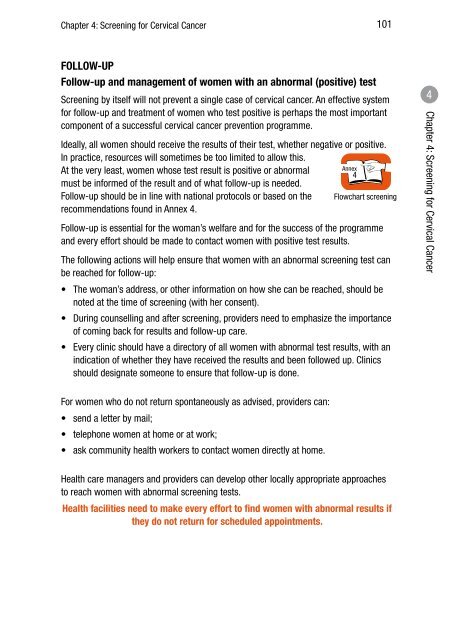CHAPTER 4: SCREENING FOR CERVICAL CANCER
CHAPTER 4: SCREENING FOR CERVICAL CANCER
CHAPTER 4: SCREENING FOR CERVICAL CANCER
Create successful ePaper yourself
Turn your PDF publications into a flip-book with our unique Google optimized e-Paper software.
Chapter 4: Screening for Cervical Cancer 101FOLLOW-UPFollow-up and management of women with an abnormal (positive) testScreening by itself will not prevent a single case of cervical cancer. An effective systemfor follow-up and treatment of women who test positive is perhaps the most importantcomponent of a successful cervical cancer prevention programme.Ideally, all women should receive the results of their test, whether negative or positive.In practice, resources will sometimes be too limited to allow this.At the very least, women whose test result is positive or abnormalAnnex4must be informed of the result and of what follow-up is needed.Follow-up should be in line with national protocols or based on the Flowchart screeningrecommendations found in Annex 4.Follow-up is essential for the woman’s welfare and for the success of the programmeand every effort should be made to contact women with positive test results.The following actions will help ensure that women with an abnormal screening test canbe reached for follow-up:• The woman’s address, or other information on how she can be reached, should benoted at the time of screening (with her consent).• During counselling and after screening, providers need to emphasize the importanceof coming back for results and follow-up care.• Every clinic should have a directory of all women with abnormal test results, with anindication of whether they have received the results and been followed up. Clinicsshould designate someone to ensure that follow-up is done.4Chapter 4: Screening for Cervical CancerFor women who do not return spontaneously as advised, providers can:• send a letter by mail;• telephone women at home or at work;• ask community health workers to contact women directly at home.Health care managers and providers can develop other locally appropriate approachesto reach women with abnormal screening tests.Health facilities need to make every effort to find women with abnormal results ifthey do not return for scheduled appointments.
















